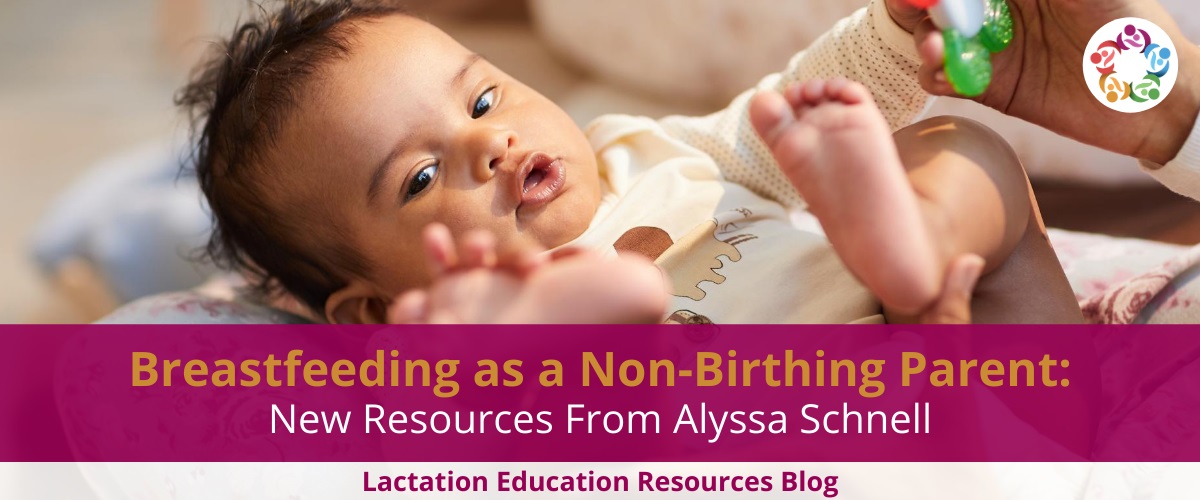Breastfeeding as a Non-Birthing Parent: New Resources from Alyssa Schnell


A parent schedules a prenatal consult with you and explains, “I am expecting a baby via surrogate, and I’m interested in inducing lactation. But I’m not really interested in taking medication. Is it still possible?” Or a parent who is planning to adopt says, “I’d love to induce lactation. I could be matched with a baby tomorrow and bring them home next week… or I could be waiting for a year or more. How do I plan for that?”
Alyssa Schnell, MS, IBCLC is an experienced lactation consultant and the author of the book “Breastfeeding Without Birthing.” Her new Lactation Education Resources conference, "The Supply Solution: Comprehensive guide to establishing, increasing, inducing & supporting milk production," includes three courses sharing her extensive research and clinical experience with induced lactation. Below, she shares some key points about the importance of understanding and customizing a plan for each family:
Moving beyond medical protocols
A medical protocol to induce lactation was developed years ago, and many people have used it successfully. It is often the default protocol recommended when someone is interested in inducing lactation. But as Schnell counseled more and more families, she realized the protocol wasn’t a good fit for everyone. She was discouraged when some interested patients felt that because they were unwilling or unable to follow that exact protocol, they wouldn’t be able to induce lactation after all.
“I thought wait, wait, that can’t be right - there can’t be just one way that we induce lactation,” Schnell says. “I started doing a lot more research and discovered that there are other protocols out there for inducing lactation.” She’s combined her research, our fundamental understanding of how inducing lactation works, and her own extensive clinical experience to develop a three-step plan for inducing lactation that can be used by any parent wanting to induce. Each step is flexible and can be modified and customized - or even skipped - to fit the parent’s needs and circumstances.
There are alternatives to prescription medication
Some patients are unable to or unwilling to take prescription medications that are commonly used to induce lactation. At each step, there are non-medication approaches if medication is not right for that individual parent. Those same approaches can also augment protocols that call for medication. Herbs, alternative therapies like acupressure and acupuncture, and manual techniques like breast massage are all ways to support milk production. Each should be customized to the parent’s specific situation, goals, and health history.
It’s not just adoptive parents interested in inducing lactation
The most frequently discussed scenario for inducing lactation is that of an adoptive parent. But there are many other people who may contact an IBCLC for support with inducing lactation, including an intended parent (baby arriving via surrogacy); the partner of a gestational parent; a transfeminine parent; and more. “I want to walk attendees through each of these circumstances and help you understand what the different needs and nuances are for each of them,” Schnell says.
A parent does not need to induce lactation to nurse!
Schnell explains that while parents and lactation consultants can often become very focused on the goal of milk production, it is not necessary to induce lactation to establish a nursing relationship. Without making any particular effort to establish milk production, the parent may choose to comfort-nurse the baby (for example, nursing to sleep, nursing after the baby has had a bottle, and/or feeding the baby using a nursing supplementer at the breast/chest). “The intention is to have the benefits of the closeness and the physical components of baby feeding at the breast or chest, and not emphasize about getting the parent’s milk,” Schnell notes. While those approaches may encourage the body to make some milk, the focus is on the bonding and nurturing that come from the nursing relationship.
Both sharing her own story and the stories of the many patients she has worked with, Schnell illustrates the many different ways induced lactation can look, and provides specific tools and strategies for the IBCLC counseling any family interested in inducing lactation. And beyond induction, “I also hope that this information will help you with other situations as well,” Schnell says. “This information applies to relactation, insufficient glandular tissue, breast reduction surgery, and any other low milk production issue.”
Ready for More?
Enroll in Schnell's three-part online conference, "The Supply Solution: Comprehensive guide to establishing, increasing, inducing & supporting milk production." Enjoy the on-demand conference at home on your own time.
Conference DetailsLooking for other resources on relactation?
Check out our free fact sheet here
Related Posts
By accepting you will be accessing a service provided by a third-party external to https://www.lactationtraining.com/
